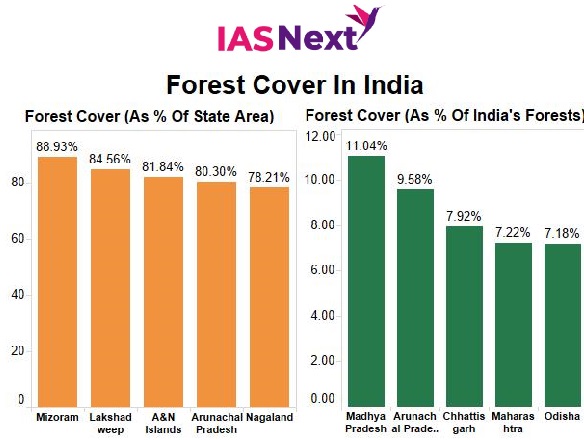CURRENT AFFAIRS
Get the most updated and recent current affair content on Padhaikaro.com
Huge Forest Loss in India
- IAS NEXT, Lucknow
- 11, Nov 2021

Reference News:
Impact of agricultural expansion on global deforestation almost 90%, says FRA remote-sensing survey.
- More than half of global forests (52.3 per cent) has been converted to cropland
- Another 37.5 per cent was lost to livestock grazing between 2000 and 2018
- Around 5.6 per cent of forest was converted for urban and infrastructure development
- Most of the deforestation was in the tropical biomes during 2000-2018
- A total of 420 million hectares of forest has been lost since 1990
- Almost 90 per cent of deforestation worldwide was due to agricultural expansion.
Slowdown was reported in South America and south and south-east Asia; tropical rainforests in these regions recorded the highest deforestation rates of all biomes.
Deforestation
- Large-scale removal of trees from forests (or other lands) for the facilitation of human activities.
- Result in the loss of biodiversity, damage to natural habitats, disturbances in the water cycle, and soil erosion.
- Contributor to climate change and global warming.
Reasons:
- Agriculture – small-scale and large scale farming
- Logging – cutting of trees for use as raw material
- Mining and urban expansion – clearing of forest area for the construction of infrastructure
Main deforestation drivers (differ across the world’s regions)
- Agriculture is the main driver of deforesation in all regions except Europe, where urban and infrastructure development have a higher impact
- Conversion to cropland dominates forest loss in Africa and Asia, with over 75 per cent of the forest area lost converted to cropland
- In South America, almost three quarters of deforestation was due to livestock grazing
What has NOT worked:
- Increasing agricultural food productivity to meet the demands of a growing population and halting deforestation are not mutually exclusive objectives.
- Globally, nature-based solutions such as forests, mangroves and peatlands could provide about a third of the most effective and cost-effective solutions to the climate crisis that we need now – as well as helping communities adapt to the changes that are now inevitable. But currently, they attract just 3% of total global climate finance. That makes no sense at all.
- If we were to lose any of the world’s great forests, we would have zero chance of stabilising the world’s climate, of staying within 1.5C of warming, of reversing the catastrophic loss of wildlife.
The Bonn Challenge
- Pledged to restore 21 MHA of degraded and deforested land which was later revised to 26 MHA to be restored by 2030.
- The first-ever country progress report under the Bonn Challenge was submitted by India – by bringing 9.8 million hectares since 2011 under restoration is an achievement.
- However, continued degradation and deforestation need to be tackled effectively to achieve the remaining target of restoration by addressing various challenges.
The Way Forward
- If we want to protect and restore nature at scale, we need to back the indigenous communities that have defended their forest homes for generations, without meaningful support or recognition and often in the face of chronic danger. Indigenous people’s lands are home to more than a third of the world’s intact forest landscapes and almost a quarter of the carbon stored in the world’s tropical forests.
- Territorial rights of Indigenous peoples must be recognized, protected forest areas expanded and roads and industry avoided in still intact forests. These steps can set the stage for more sustainable forest economies.
- India would do well to set up an ambitious goal of first retaining and then increasing its forest cover. Protecting tropical forests can secure seven to 10 times as much carbon through 2050 as replanting forests. Saving the trees can also ease the crisis of species extinction. And protecting these forests is crucial to maintaining the homes and ways of life of thousands of forest cultures.
- A forest policy should be a broad vision taking into account the varied political, socioeconomic, and ecological contexts of the country. Adequate finance along with public-private partnership can propel the efforts towards restoration of the planned interventions. Active engagement of stakeholders and an inclusive approach can turn the table!
NOTE: FRA 2020 Remote Sensing Survey
- Launched in 2018
- To build country capacities to use remote sensing for forest monitoring
- To generate independent, robust and consistent estimates of forest area and its changes over time at global, regional and biome levels.